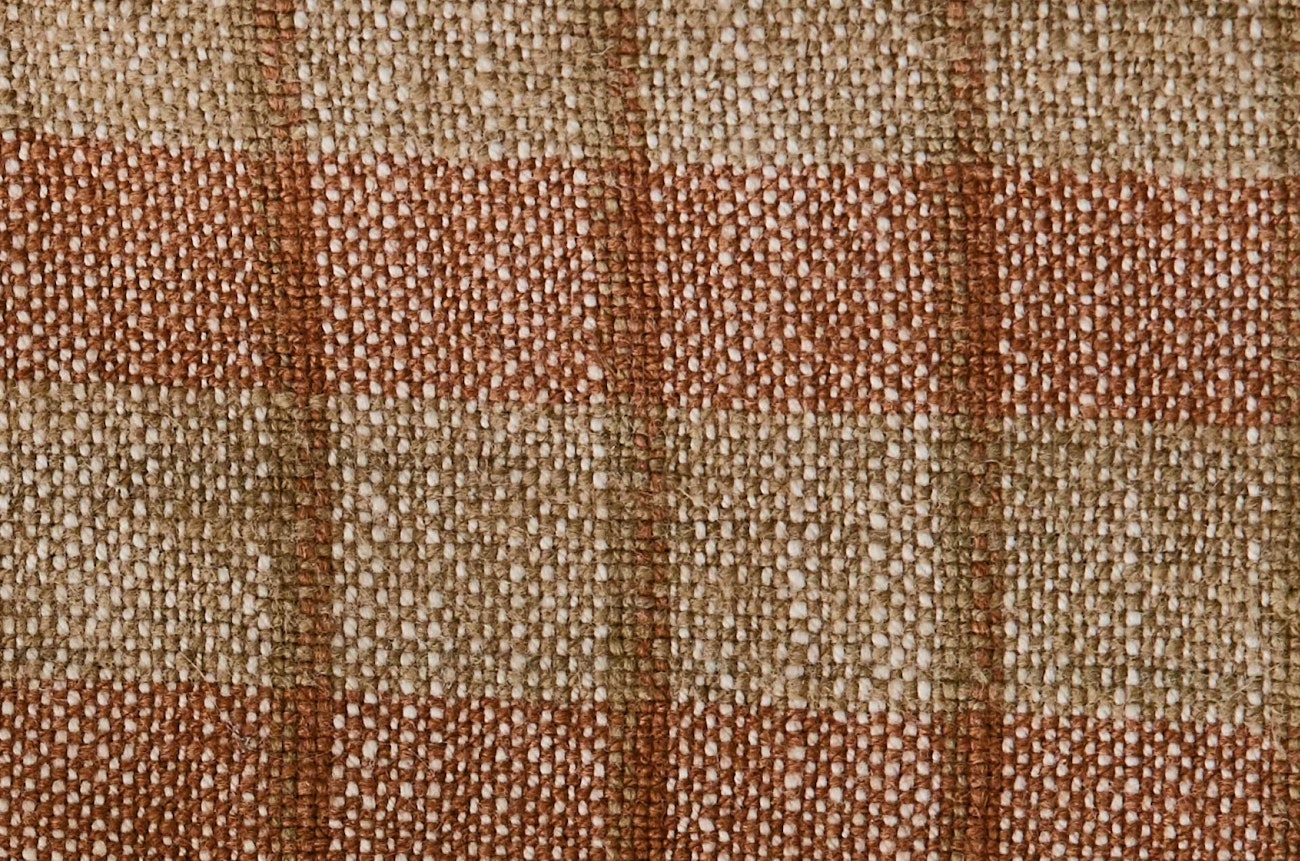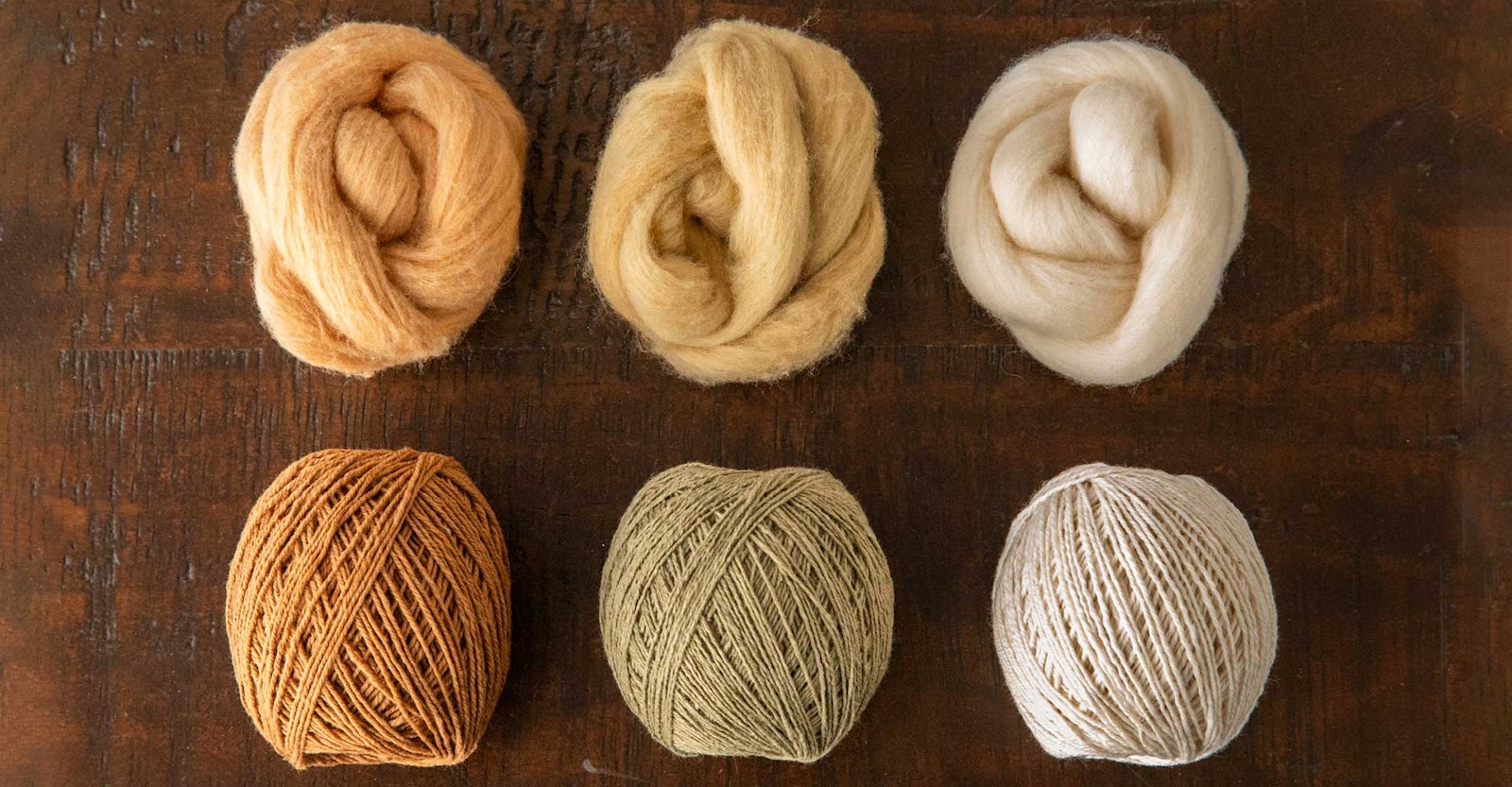I have always loved natural-color cotton, and initially, I used my handspun cotton yarns only for weaving. I had tried knitting with commercially spun cotton yarn earlier in my fiber life and did not like it. It had little or no memory or elasticity, and knitting with cotton hurt my hands.
 Devin’s handspun cotton used in weaving. Photo by George Boe
Devin’s handspun cotton used in weaving. Photo by George Boe
I loved spinning cotton, though, and eventually I was convinced to try knitting with handspun cotton and found the experience totally different. I started first by using yarn spun on spindles during meetings at work. The singles had less twist than I normally use, so I plied it a little looser as well. I ended up with a fun scarf showcasing the many colors of cotton I had in my stash. My next project was a T-shirt knitted from cotton spun and plied on my e-spinner. I purposely added a little less twist and aimed for a coherent but not firmly twisted yarn. To my surprise, I found that my handspun cotton—even after boiling during finishing—had a discernable amount of elasticity and slightly more memory than I found in commercial cotton yarns. It was a joy to knit with.
 Devin wears the handspun cotton woven shirt they made, with the goal of making a shirt from raw fiber to finished object. Read all about it in the Spring 2019 issue of Spin Off. Photo by Kate Larson
Devin wears the handspun cotton woven shirt they made, with the goal of making a shirt from raw fiber to finished object. Read all about it in the Spring 2019 issue of Spin Off. Photo by Kate Larson
Handspun Cotton Socks?
I knit several pairs of wool socks every year, and after completing the cotton T-shirt, I knew I wanted to try a pair of handspun cotton socks. My first thought was of the Magdalena de Cao Viejo Stockings by Carrie Brezine, published in a 2014 issue of PieceWork. The article and pattern, exploring textile history and archaeology, stuck in my mind for years. I decided I would knit the pattern and see if I liked knitting—and especially wearing—handspun cotton socks.
I had some brown and cream-colored handspun from the T-shirt project and needed one more color. As I dug in my stash, I found a green that was slightly finer but would work. I had spun the cream and brown yarns specifically for knitting, with slightly thicker and lower-twist singles and a balanced plying twist; they were close to a fine laceweight. The green, however, was a finer and more irregular singles with balanced plying twist, which I would equate with a gossamer laceweight yarn. All three yarns were three-ply. I knitted a gauge swatch using the three-ply yarns and size 1 (2.25 mm) needles. The result was a good fabric, though it was slightly finer than the gauge required for the socks.
I am used to altering sock patterns to fit my wide ankles and feet, and I altered this pattern as well. Since my gauge was finer than the original pattern, I added stitches to the cast-on for a total of 100 stitches, and when I knitted the leg, I worked fewer decrease rounds for calf shaping. For the rest of the sock, I adjusted the numbers accordingly, and all of those changes are reflected in the adapted version of the original project on page 26 of Spin Off Summer 2024.
 Devin spun the cream and brown yarns specifically for knitting, with slightly thicker and lower-twist singles and a balanced plying twist. Photo by Matt Graves
Devin spun the cream and brown yarns specifically for knitting, with slightly thicker and lower-twist singles and a balanced plying twist. Photo by Matt Graves
Successful Socks
The knitting itself was pleasant. I always love working with my handspun, and making socks from handspun cotton was exciting for me. It’s thrilling to accomplish something new in my spinning and textile work. The color changes kept the knitting interesting, and I loved seeing the natural colors of the cotton working together to make a pattern. The instructions make particular mention of measuring gauge only after washing and drying the sample, and I did not do this. It could have been a problem, which is why Carrie included the note in the original instructions, but I was very lucky. After knitting, the socks seemed too big and rather loose, but once I washed them in my standard washing machine on regular cycle in cold water with my normal clothes and hung them to dry, they fit snugly and comfortably to my feet. I could have easily been unlucky and had the socks be too small. Going forward, I will make sure to wash and finish my gauge swatches for handspun cotton, since it doesn’t have the elasticity of wool that I’m used to when knitting socks.
I had never knitted or worn a garter-stitch heel, and I was worried about the feel of the garter ridges, but the heel is surprisingly comfortable. In fact, the shape suits my foot better than the German heel I usually knit.
 Detail of Devin’s handspun knitted socks. Photo by Matt Graves
Detail of Devin’s handspun knitted socks. Photo by Matt Graves
My Magdalena de Cao Viejo Stockings got some wear last summer with sandals indoors and with some brown leather shoes. They are delightfully comfortable, and I am looking forward to knitting several more pairs of handspun cotton socks, which will expand my handspun wardrobe even more. I highly recommend revisiting handspun cotton for knitting if, based on experience with millspun, you had decided it was not for you.
Resources
- Brezine, Carrie. “Magdalena de Cao Viejo Stockings.” PieceWork, January/February 2014, 15–17.
- ———. “The Oldest Knitting in the New World.” PieceWork, January/February 2014, 11–14.
- Helmen, Devin. “To Spin a Shirt.” Spin Off, Spring 2019, 34–38.
This article was first published in Spin Off Summer 2024.
Also, remember that if you are an active subscriber to Spin Off magazine, you have unlimited access to previous issues, including Summer 2024. See our help center for the step-by-step process on how to access them.
Devin Helmen has been immersed in fiber since learning to spin at age eight. They spin, knit, and weave in beautiful Minnesota. Devin enjoys writing and teaching about fiber arts and has a passion for spindles and everyday textiles. They blog, intermittently, at afewgreenfigs.blogspot.com.

